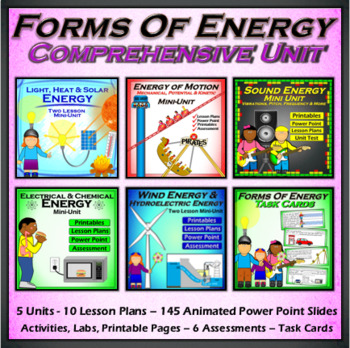Forms of Energy Comprehensive Unit - 5 Unit Bundle, 10 lessons, PPT, Printables
- Zip
- Easel Assessment
What educators are saying
Products in this Bundle (7)
showing 1-5 of 7 products
Also included in
- This ultimate science (growing) bundle is everything you need for your 4th and 5th grade science class overloaded with resources that will enhance your classroom in an incredible way. With the incredible animations in the power points, the extensive reading articles, labs and science activities, andPrice $149.50Original Price $205.80Save $56.30
Description
This 5 unit, 10 lesson bundle is everything you need to teach your students about the forms of energy. With incredible power point animations in 145 slides, 10 lesson plans, STEAM activities and lab activities, a total of 40 printable pages for your students and 5 mini-unit quizzes as well as task cards and a summative forms of energy unit assessment that will assess your students' knowledge on sound energy, vibrations, pitch, frequency, electrical energy, chemical energy, light energy, heat energy, solar energy, wind energy, hydroelectric energy, and the energy of motion including potential, kinetic, mechanical energy and energy transfer. Let this comprehensive unit take the stress of 4-6 weeks of planning and finding additional quality resources away, so you can just focus on your passion: teaching.
What other buyers have said about this unit bundle:
"Excellent Excellent Resource... looking forward to more resources in the same format. The power point slides were exceptional, very detailed and informative. I enjoyed teaching this unit on science more than any other subject."
*************************************************************************************************************
This unit has everything that you need to teach your children about the major forms of energy all while keeping them engaged with some of the most amazing power point animations you have ever seen, and fun and engaging activities and labs for your kids to participate with. You and your students will love this unit, I guarantee it!
-MrJacksbackpack






